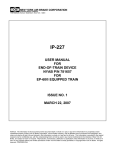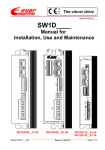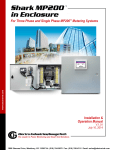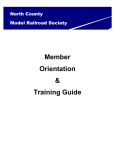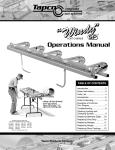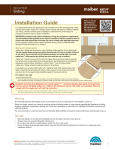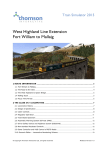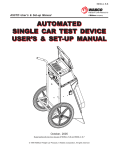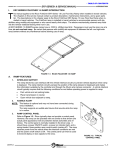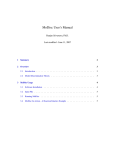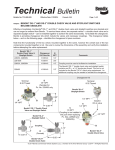Download IP-230 - New York Air Brake
Transcript
IP-230 OPERATOR INSTRUCTION AND MAINTENANCE GUIDE FOR TRAINLINE ENERGIZING DEVICE (TED) April 2009 Issue No. 2 © Copyright New York Air Brake All rights reserved. THIS PAGE INCLUDED FOR DOUBLE SIDED COPYING APRIL/09 B © Copyright New York Air Brake All rights reserved. IP-230 Revision Level Section 01 ALL Original Release June/07 02 3.3 3.5 Add Section 3.3 Servicing the Fuse Add Reference No. 5, Fuse April/09 IP-230 Change C © Copyright New York Air Brake All rights reserved. Date APRIL/09 THIS PAGE INCLUDED FOR DOUBLE SIDED COPYING APRIL/09 D © Copyright New York Air Brake All rights reserved. IP-230 TABLE OF CONTENTS 1.0 DESCRIPTION..................................................................................................................1 1.1 SYSTEM ...........................................................................................................................1 1.1.1 Purpose .....................................................................................................................1 1.1.2 Overview of Trainline Energizing Device...................................................................1 1.1.3 Overview of Car Control Device (CCD) Brake Pipe Limited Emulation.....................1 1.2 LEDS.................................................................................................................................2 1.3 INTERFACES ...................................................................................................................3 1.3.1 Trainline Interface......................................................................................................3 1.3.2 Line Voltage Interface ...............................................................................................3 2.0 FUNCTIONAL INSTRUCTIONS .......................................................................................5 2.1 SETTING A ECP TRAIN INTO BRAKE PIPE LIMITED EMULATION (BPLE) MODE......5 2.2 ENDING BRAKE PIPE LIMITED EMULATION (BPLE) MODE ........................................7 3.0 MAINTENANCE ................................................................................................................9 3.1 CHARGING THE BATTERY .............................................................................................9 3.2 SERVICING THE BATTERY.............................................................................................9 3.3 SERVICING THE FUSE..................................................................................................10 3.4 CONNECTING THE BATTERY ......................................................................................11 3.5 REPLACEABLE PARTS .................................................................................................12 3.6 INTER-CAR CABLE ........................................................................................................13 4.0 TROUBLE SHOOTING ...................................................................................................14 4.1 TED LED’S......................................................................................................................14 4.2 CCD EMULATION MODE...............................................................................................14 5.0 RETURN MATERIAL AUTHORIZATION PROCESS .....................................................16 6.0 LIST OF ABBREVIATIONS.............................................................................................18 IP-230 E © Copyright New York Air Brake All rights reserved. APRIL/09 THIS PAGE INCLUDED FOR DOUBLE SIDED COPYING APRIL/09 F © Copyright New York Air Brake All rights reserved. IP-230 1.0 DESCRIPTION WARNING: 1.1 SYSTEM 1.1.1 Purpose HAZARDOUS VOLTAGE (140V). CONTACT WITH PINS WHEN ‘ENERGIZE’ INDICATOR IS LIT MAY CAUSE ELECTRICAL SHOCK AND INJURY. The intent of this User Manual, IP-230, is to familiarize an end-user with the basic operation and need for the Trainline Energizing Device (TED) for operation of ECP equipped rail wagons in brake pipe limited emulation mode. This manual instructs a user in the steps to connect, operate, and remove the device from a train, and to maintain and replace the battery. This manual does not include heavy repair maintenance, testing requirements or detailed functional descriptions. 1.1.2 Overview of Trainline Energizing Device The Trainline Energizing Device (TED) is to allow short term / distance haulage of ECP equipped train wagons without an ECP equipped locomotive. This is accomplished through setting a short train (Less than 25 wagons) up into “Limited Brake Pipe Emulation” mode. The TED is a portable device, plugged into the trainline connector at either end of a consist of ECP equipped wagons to be moved. The purpose of the TED is as follows: 1.1.3 Provide enough trainline power to “wake up” the ECP car equipment. Send the ECP wagon equipment a network message, setting them for Emulation Mode. It is estimated that a TED with a fully charged battery can be operated 25 times before recharging is required (Section 3.1). Overview of Car Control Device (CCD) Brake Pipe Limited Emulation Brake pipe limited emulation is a mode that an ECP train is setup for, that allows each CCD to respond to changes in brake pipe to apply or release brake cylinder. The CCD brake pipe limited emulation is expected to be used in trains of approximately 10 to no more than 25 wagons for haulage at low speeds by non-ECP equipped locomotives. It is expected that it will be used at a mine or to switch small cuts of wagons from the mainline track into shops or loading sites. Another possible use of emulation would be in order to move wagons off the mainline into sidings etc...in the event that certain train wide ECP failures have occurred. It is expected that Railroad operation rules will limit the use of brake pipe limited emulation so that is not used in long trains or in excess of a speed limit that should be specified by Railroad operation rules. The reason for this is based on the following: IP-230 The use of this brake pipe emulation function relies on the CCD staying powered-up using its battery back-up. When the CCD’s battery becomes low it will electrically cut-out and BC will stay released or any BC pressure applied will be released (if BP is not in emergency). This will not be detectable by the train operator, particularly if the brake pipe is in release. If several or all cars have cut-out the train operator will not know it until a service brake request is made, at which time insufficient braking may be available to stop the train. At this time the train operator would need to initiate an emergency brake pipe reduction. The CCDs including any that have cut-out will then apply BC using its pneumatic back-up brake. The emergency brake can subsequently be released, using the CCD pneumatic back-up, by recharging the brake pipe. 1 © Copyright New York Air Brake All rights reserved. APRIL/09 1.2 It is also expected that Railroad operation rules will require that a departure type brake test be performed prior to moving the train using emulation. LEDS The TED has three LED’s on the top front panel, which indicate the following: GREEN YELLOW RED DESCRIPTION Off On On Off Off Flashing Off Off Off On Flashing Off Off Off Off Off Off Off On Off Flashing Disabled / Off Ready Ready, but Low Battery Disabled, Discharged Battery Energizing Trainline, Sending Emulation Message Trainline Energized, Emulation Message Sent Error Energizing Trainline, Error Sending Message Figure 1: LEDs on Top Cover APRIL/09 2 © Copyright New York Air Brake All rights reserved. IP-230 1.3 INTERFACES The TED has two main interfaces: 1.3.1 Trainline Interface Connects, via the Inter-Car Connector, to an ECP wagon with a short train of up to twenty-five wagons to have their CCDs activated and set to brake pipe emulation mode. CAUTION: DO NOT apply any voltage into the TED through this port – substantial damage will occur. Figure 2: Trainline Interface (Inter-Car Cable) 1.3.2 Line Voltage Interface Connect a standard line cord to the IEC 320 C14 AC inlet for charging the TED’s battery. The charger is automatic, and may be left energized for extended periods of time. It is recommended that the battery charging port be connected and energized when not in use. The charger will accept 100-240 VAC. Figure 3: Line Voltage Interface IP-230 3 © Copyright New York Air Brake All rights reserved. APRIL/09 THIS PAGE INCLUDED FOR DOUBLE SIDED COPYING APRIL/09 4 © Copyright New York Air Brake All rights reserved. IP-230 2.0 FUNCTIONAL INSTRUCTIONS 2.1 SETTING A ECP TRAIN INTO BRAKE PIPE LIMITED EMULATION (BPLE) MODE 1. With zero (0) brake pipe pressure (with all brake pipe hoses connected), connect the inter-car connectors on up to twenty-five wagons together. CAUTION: NEVER connect the TED when another power source (such as an ECP equipped locomotive) is connected to the trainline. Substantial damage to the TED will occur. CAUTION: NEVER use more than one TED to attempt to energize a consist of wagons. 2. Press and hold the left-hand momentary switch. After a period of two seconds, the green ‘TED Ready’ indicator will light. If the green indicator does not light, see troubleshooting section 4.0. 3. Once the green indicator has illuminated, continue to hold the left-hand switch active. Press and hold the right-hand switch. The green indicator will extinguish, and the red ‘Energize’ indicator will illuminate, warning that 140VDC is present on the trainline. If the LED’s do not perform this way, see troubleshooting section 4.0. Left Hand Switch Right Hand Switch Figure 4: TED Switches 4. After the red LED comes on, there will be approximately 10 seconds (under normal operation) before the red LED goes out and the green LED flashes, signaling the sequence is complete. NOTE: If either the left or right-hand switch is released, the 140VDC output will be terminated, and the train may not be in BPLE mode. NOTE: If the TED detects an overload or low output voltage, the output will also be terminated. The red LED goes off immediately. 5. Remove the TED from the ECP trainline. IP-230 5 © Copyright New York Air Brake All rights reserved. APRIL/09 6. The NYAB / KNORR Car Control Devices (CCDs) have an LED that provides an indication that it has entered brake pipe limited emulation, this is indicated by the ‘COM’ LED on the CCD being lit solid (See figure 5). Wabtec wagons DO NOT indicate they have entered BPLE mode. 7. Walk the train to verify CCDs have entered emulation mode by observing the “COMM” LED is solid ‘ON’. If all or some CCDs are not in emulation mode, see troubleshooting section 4.0. NOTE: If either the left or right-hand switch is released, the 140VDC output will be terminated. NOTE: If the TED detects an overload or low output voltage, the output will also be terminated. 8. A departure type brake test is to be performed prior to moving the train using brake pipe limited emulation. This test should include charging brake pipe and inspecting the train to verify that the brakes release on all wagons, and it should also include making a service reduction in brake pipe pressure and inspecting the train to verify that the brakes apply on all wagons. 9. It is expected that the locomotive set ER/BP to 620 KPa for release pressure. Setting at a lower release pressure will result in lower BC pressures and resulting brake ratio levels. 10. Once the Car Control Devices (CCDs) have entered brake pipe limited emulation, they will use brake pipe pressure in order to determine the brake command (of application or release). Service or emergency rates of brake pipe pressure reduction will result in brake applications based on loaded weight condition. Brake pipe pressure increases will result in a direct release of brake cylinder pressure to zero (0), emulating a DB-60. Brake pipe reductions from release will result in brake cylinder applied proportional to brake pipe reduction. APRIL/09 6 © Copyright New York Air Brake All rights reserved. IP-230 2.2 ENDING BRAKE PIPE LIMITED EMULATION (BPLE) MODE 1. When exiting BPLE mode, the CCDs shut down, power off and will respond to its pneumatic back up. If brake pipe is above approximately 50 psi, brake cylinder will be 0. If brake pipe is below approximately 40 psi, brake cylinder will be applied. 2. If brake pipe pressure is vented to zero (0), the Car Control Devices (CCDs) will exit brake pipe limited emulation mode. If it is desired to continue operation in brake pipe limited emulation mode, the Trainline Energizing Device would need to be reconnected and operated as described in section 2.1. 3. There are other conditions when the Car Control Devices (CCDs) will exit brake pipe limited emulation mode including: ECP Head End Unit (HEU) beacons and trainline power are received. If the CCD battery becomes insufficient or upon detection of internal faults. If brake pipe does not exceed 45 PSI (310 KPa) after entering BP emulation after one (1) hour. PWR: Power LED COM: Communication LED. Should be steady during emulation mode BRK: Brake application LED FLT: Fault LED Figure 5: CCDs IP-230 7 © Copyright New York Air Brake All rights reserved. APRIL/09 THIS PAGE INCLUDED FOR DOUBLE SIDED COPYING APRIL/09 8 © Copyright New York Air Brake All rights reserved. IP-230 3.0 MAINTENANCE 3.1 CHARGING THE BATTERY It is suggested that the TED’s battery charger line input port be connected to 100-240 VAC when not in use. The built-in battery charger contains circuitry to inhibit charging if the battery is damaged. The charger also will apply a fast charge initially, but will switch to a float / trickle charge when fast charging has been completed. 3.2 SERVICING THE BATTERY The TED requires a 12V, 5A-hr, sealed lead acid battery, NYAB P/N 774481. There is no necessity for a pre-defined battery replacement schedule, as battery life is dramatically influenced by how the TED is used. However, when the TED no longer has the ability to consistently energize the trainline, as indicated by the yellow ‘Low Battery’ or red ‘Fault Condition’ LEDs, the battery will need to be replaced. This is accomplished by: 1. Remove the battery compartment cover (lower section of the top front of the TED). This only requires a Phillips screwdriver. 2. Lift out the old battery, and disconnect the two wires. They are connected with ¼” quick disconnects. 3. DO NOT reverse the battery leads – this will damage the TED. 4. Connect the red, positive lead from the TED to the new battery’s positive terminal. This connector is also at a 90-degree angle. (See section 3.3). 5. Connect the black, negative lead from the TED to the new battery’s negative terminal. This connector is straight. (See section 3.3). 6. Install the new battery; it will fit in only one orientation. Slide the wires fully inside of the battery compartment. 7. Replace the compartments cover and torque the screws to 21-23 in-lbs. Dispose of the old battery properly. Figure 6: Battery Compartment w/o battery IP-230 Figure 7: Battery Compartment w/ battery 9 © Copyright New York Air Brake All rights reserved. APRIL/09 3.3 SERVICING THE FUSE The TED has a fuse inline with the power coming into the unit for battery charging. This fuse is intended to protect the transformer and battery charging circuit. In the event that the TED will no longer charge a battery, both the battery and fuse may be inspected together. The fuse is located within the battery compartment. Refer to the previous section, 3.2, regarding battery service. In order to inspect the fuse, the battery compartment cover must be removed, using a Phillips screwdriver. The fuse holder is attached to the battery wires, and is typically located near the lower right-hand corner of the compartment, between the battery cradle and outside cavity walls. The battery must be set aside before the fuse holder can be fished out. Figure 8: Fuse Holder WARNING: THE TED MUST BE DISCONNECTED FROM THE POWER CORD WHEN REMOVING OR INSTALLING A FUSE. LINE VOLTAGE (110VAC-240VAC) IS PRESENT INSIDE THE FUSE HOLDER. FAILURE TO DISCONNECT MAY RESULTS IN PROPERTY DAMAGE, PERSONAL INJURY, OR DEATH. The fuse holder is opened by holding the body, and then pressing down and twisting counterclockwise the cap. If the fuse element is blown away, replace the fuse with a 1-Amp, 250V, FastActing, 3AG type fuse, NYAB P/N 761660. WARNING: APRIL/09 DO NOT SUBSTITUE ANY FUSE THAT DOES NOT CONFORM TO THE ABOVE SPECIFICATIONS. DOING SO MAY LEAD TO PROPERTY DAMAGE, PERSONAL INJURY, OR DEATH. 10 © Copyright New York Air Brake All rights reserved. IP-230 3.4 CONNECTING THE BATTERY When the TED is shipped from New York Air Brake, the battery is left disconnected. It must be reconnected before its first use. Complete instructions are in section 3.3. The positive wire needs to be connected to the positive terminal on the battery and the negative wire to the negative terminal on the battery. Cross connecting the terminals could result in serious injury and damage to the TED. The positive terminal on the battery is marked red. The positive wire has a strip of red casing on the wire, a strip of white casing on the wire with +++ markings, as well as a 90 degree connector. The negative terminal on the battery is marked black. The negative wire has a strip of white casing on the wire with – markings as well as a straight connector. Red Positive Casing on wire White casing with +++ markings 90 degree connector Straight Connector White casing with - markings Positive battery terminal Negative battery terminal Figure 9: Detailed Battery Connections IP-230 11 © Copyright New York Air Brake All rights reserved. APRIL/09 3.5 REPLACEABLE PARTS KEY DRAWING REFERENCE NUMBER DESCRIPTION NYAB PART NUMBER 1 Cover Screw 784056 2 Battery Cover 783958 3 Battery 774481 4 Complete TED 782936 5 Fuse, 1A 761660 Figure 10: Assembly of TED APRIL/09 12 © Copyright New York Air Brake All rights reserved. IP-230 3.6 INTER-CAR CABLE In the event that the trainline interface of the TED becomes damaged and needs to be replaced, refer to section 5.0 to contact a NYAB representative. Figure 11: Inter-Car Cable IP-230 13 © Copyright New York Air Brake All rights reserved. APRIL/09 4.0 TROUBLE SHOOTING 4.1 TED LED’S GREEN YELLOW RED Off Off Off Will not power up. 1. Replace battery. If it doesn’t work, 2. Refer to section 5.0 to contact NYAB representative. On On Off Low Battery Charge the battery ASAP. Off Flashing Off Battery is dead and will not charge the trainline Immediately charge the battery. Error energizing trainline and sending message 1. Make sure you don’t release either switch until the trainline is energized. 2. Try again. If it does not work, 3. Make sure there are 25 or less wagons. If ok, 4. Make sure the all trainline wiring is connected. If ok, 5. Replace the battery. If it still does not work, refer to section 5.0 to contact a NYAB representative. Off 4.2 Off Flashing DESCRIPTION CORRECTIVE ACTION CCD EMULATION MODE If the CCDs are in emulation mode, the ‘COMM’ LED will be solid. If all CCDs are not in emulation mode, follow these steps: 1. Power down the TED by releasing either or both switches. 2. Walk train to verify all ECP inter-car connectors are connected. 3. Verify all wagon brake pipe hoses are connected and brake pipe is zero (0). 4. Verify the CCD – IDM cable is connected. 5. Check all CCDs NOT in emulation mode for the fault LED on. 6. Verify all CCDs have batteries and batteries are charged. 7. Re-try energizing the trainline using the procedure in section 2.1. For additional information on CCDs and emulation mode, refer to section 2.2. APRIL/09 14 © Copyright New York Air Brake All rights reserved. IP-230 THIS PAGE INCLUDED FOR DOUBLE SIDED COPYING IP-230 15 © Copyright New York Air Brake All rights reserved. APRIL/09 5.0 RETURN MATERIAL AUTHORIZATION PROCESS All material returned from the field to New York Air Brake (NYAB)/Knorr, must have a Return Material Authorization (RMA) number. A NYAB/Knorr representative will provide the RMA number. To receive a RMA number and to get additional information regarding the RMA process, call: Knorr Bremse – SA Kempton Park, South Africa Telephone: (011) 961-7800 KBL/KNORR Kingston, Ontario, CANADA Telephone: (613) 389-4660 Ext. 328 OR NYAB/KNORR Watertown, New York, USA APRIL/09 Telephone: (315) 786-5494 16 © Copyright New York Air Brake All rights reserved. IP-230 THIS PAGE INCLUDED FOR DOUBLE SIDED COPYING IP-230 17 © Copyright New York Air Brake All rights reserved. APRIL/09 6.0 LIST OF ABBREVIATIONS BC BP BPLE Brake Cylinder Brake Pipe Brake Pipe Limited Emulation CCD Car Control Device ECP ER Electrically Controlled Pneumatic Brake Control System Emergency Reservoir IDM Identification Module TED Trainline Energizing Device APRIL/09 18 © Copyright New York Air Brake All rights reserved. IP-230
























